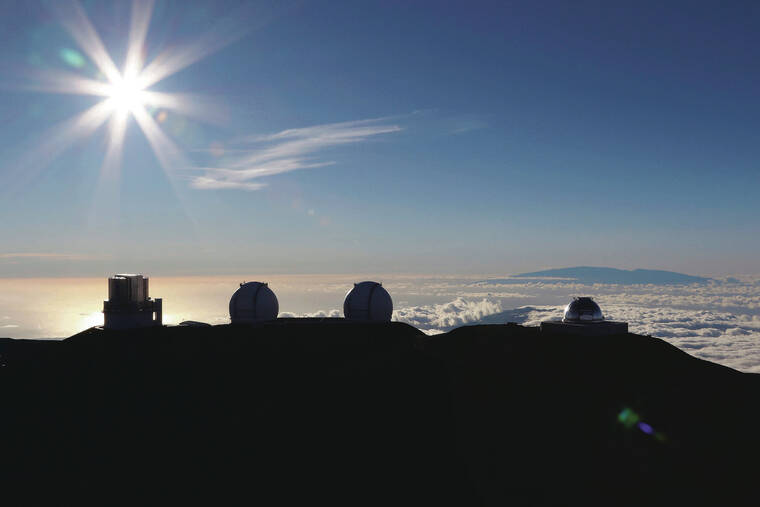The state’s astronomy sector pumped $110 million into Hawaii’s economy in 2019 and generated an overall economic impact twice that, according to the summary of a University of Hawaii report released today.
The report by the University of Hawaii Economic Research Organization indicates that astronomy’s overall economic impact of $221 million, which includes indirect expenditures, is nearly as much as agriculture statewide.
“Money is being injected at a fairly impressive clip — at $100 million a year directly,” said Doug Simons, director of the UH Institute for Astronomy. “You add that up over the 50 years of astronomy and that’s billions of dollars invested in our state economy.”
The astronomy figures were released as the state Legislature is preparing to consider a proposal to change management of the Mauna Kea summit from UH to a nine-member stewardship authority.
Among other things, House Bill 2024 requires the new entity to develop a framework to limit astronomy development and create a plan to return the summit to its natural state at some future point.
The bill reflects the findings of the 15-member Mauna Kea Working Group, established last year by the state House of Representatives and charged with coming up with an alternative form of management for the state lands on the mountain above 6,500 feet, including the science reserve.
The university, however, has criticized the group’s recommendations, saying they put the future of astronomy in Hawaii at risk.
Not only would the state’s economy lose if the Mauna Kea observatories disappear, university officials said, but the science of astronomy would be dealt a huge setback with the loss of some of the most productive telescopes in the world.
Simons, the former director of the Canada-France- Hawaii Telescope and Gemini Observatory, said the loss of the Mauna Kea observatories would create a huge blind spot in the northern sky for modern astronomy. Space telescopes, he said, can do only so much.
“It’s a really big universe. There’s a tremendous amount of research that can only really be done from the ground,” he said. “It would be an absolutely devastating blow to the field of astronomy if we were to lose Mauna Kea. It would just be devastating.”
UH officials said the economic report has been in the works for some time and the timing of the summary’s release was coincidental to the legislative proposal, though fortuitous as lawmakers consider the bill.
“Obviously it aligns very well with our response to the Mauna Kea Working Group report,” said Greg Chun, executive director of the UH Hilo Center for Maunakea Stewardship. “We’re very hopeful that it does add to the conversation. We think the economic component needs to be understood by the broader community and by the Legislature.”
The full UHERO report on the economic impact of astronomy is expected to be completed by summer.
The report is designed to update a 2014 UHERO report that revealed a $99.43 million economic impact from astronomy in 2012. (The original figure of $88.09 million was recalculated in 2019 dollars in the latest report for comparison’s sake.)
The updated study found that astronomy generated $110 million in direct expenditures across the state. That includes purchases from local businesses, salaries and wages, and spending by students and visiting researchers.
Astronomy also supported employment of 1,313 residents while generating $221 million in total economic impact, including the output of goods and services plus direct and indirect economic effects.
The report pegged the total economic impact from astronomy on Hawaii island at $102 million, or 46% of the statewide astronomy impact, while supporting 611 jobs.
On Oahu, astronomy generated $87 million and 517 jobs, while $31 million was generated on Maui, along with 176 jobs.
Statewide, astronomy activities created $68 million in labor income and $10 million in state taxes, according to the UHERO report.
“Astronomy continues to be a sizable and stabilizing source of economic activity,” the report says. “Astronomy output for 2019 was equivalent to 78% of the total farming output statewide, or 21% of the output from the private educational services sector.”
Simons called Mauna Kea the core of Hawaii astronomy, and without it, only 10% to 20% of its economic impact would remain for the state.
He also said UH’s renowned astronomy research and educational program would be reduced to a smaller, garden-variety university department.
“It would be a huge blow to the program here, there’s no doubt about that,” he said.
Mauna Kea’s summit is home to 13 observatories. The UH Board of Regents this month approved a master plan that calls for a maximum of nine observatories atop Hawaii’s tallest mountain after 2033, when UH’s lease of the Mauna Kea Science Reserve expires.
One of the nine may be the controversial Thirty Meter Telescope, but plans for the cutting-edge facility continue to be on hold while it works to win additional funding through the National Science Foundation and other entities willing to invest in the $2.65 billion project.
But even if that effort is a success, the TMT will have to find a way to materialize in the face of a Native Hawaiian-led movement that has vowed to block its construction just as it did in 2015 and 2019.
The 15-member Mauna Kea Working Group, composed of a mix of politicians, Mauna Kea officials and Native Hawaiians, issued its report recommending changes on the mountain last week. The report called for a reshuffling of management because, in part, UH allowed culture and science to clash, leading to conflicts on the mountain.

